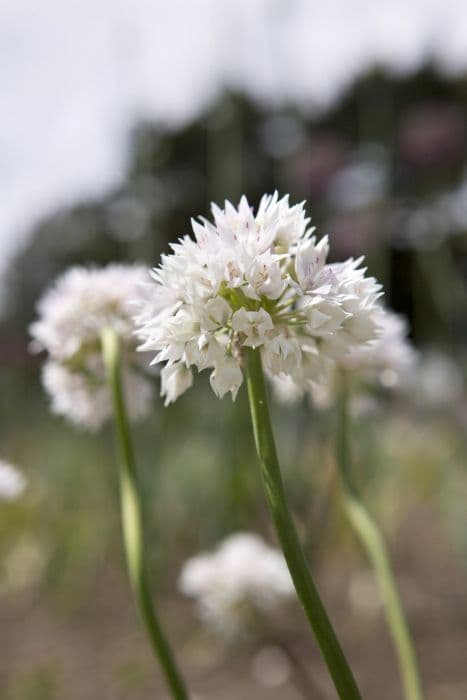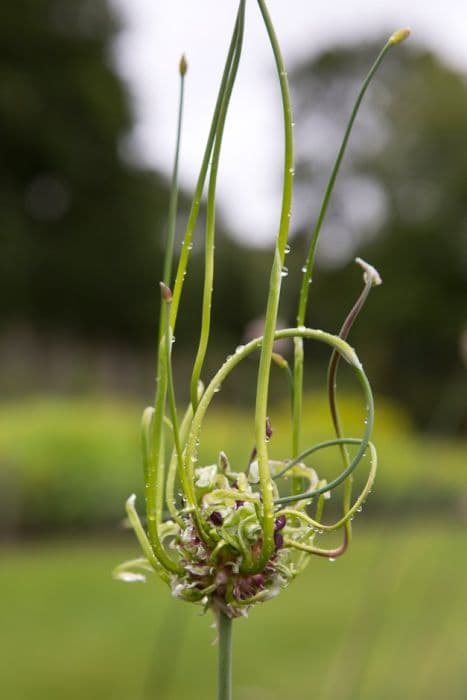Welsh onion Allium fistulosum











ABOUT
The plant commonly known as Welsh onion features a bundle of long, slender, tubular green leaves that emerge directly from the base, forming a tuff similar to common grass. These leaves are hollow and round in cross-section, tapering to a point at the top. The green of the leaves is a bright, vibrant hue, providing an attractive verdancy to the plant's appearance. The base of the plant includes a white portion, as the color transitions from the pure green of the leaves to a paler, almost translucent white that wraps around the lower section of the plant where it meets the soil, resembling the familiar white bulb of a spring onion but elongating as it continues into the root system. Welsh onion can produce tall flowering stalks that are round and solid, unlike the hollow leaves, eventually blooming with clusters of small globular head of flowers. These flower clusters can be a variety of colors, typically white, cream, pink, or light purple, and they form a tight umbel at the top of the stalk. The flowers are attractive to a range of pollinators. After flowering, the plant can produce small black seeds. Overall, Welsh onion's appearance is characterized by its bunching habit and simple yet vibrant coloration, providing visual interest predominantly through its foliage and, when present, its delicate flowers.
About this plant
 Names
NamesFamily
Amaryllidaceae.
Synonyms
Welsh Onion, Japanese Bunching Onion, Green Onion, Spring Onion, Salad Onion, Scallion, Tokyo Negi, Shandong Negi, Cong Bai.
Common names
Allium fistulosum L.
 Toxicity
ToxicityTo humans
Allium fistulosum, commonly known as the Welsh onion, is not considered toxic to humans and is widely consumed in various cuisines around the world. There are no known toxic consequences from ingesting this plant, and it is generally safe when used as a culinary herb or vegetable. However, as with any food, overconsumption or individual allergies could potentially cause adverse effects. Individuals with a known sensitivity to allium species may experience mild symptoms such as digestive discomfort, but this is not common.
To pets
Allium fistulosum, commonly known as the Welsh onion, is considered toxic to pets, especially cats and dogs. The toxicity is due to the presence of N-propyl disulfide and thiosulphate which can cause oxidative damage to red blood cells leading to hemolytic anemia. Symptoms of poisoning in pets may include vomiting, diarrhea, abdominal pain, loss of appetite, weakness, and lethargy. In severe cases, ingestion can lead to difficulty breathing, increased heart rate, and collapse. If you suspect your pet has consumed Welsh onions, it is important to seek veterinary care promptly.
 Characteristics
CharacteristicsLife cycle
Perennials
Foliage type
Evergreen
Color of leaves
Green
Flower color
White
Height
2 feet (60 cm)
Spread
0.5 foot (15 cm)
Plant type
Herb
Hardiness zones
5
Native area
Asia
Benefits
 General Benefits
General Benefits- Allium fistulosum, commonly known as 'Welsh onion', is a flavorful addition to dishes, offering a mild onion taste that enhances the overall flavor profile of culinary creations.
- It provides a source of vitamins and minerals, contributing to a balanced and nutritious diet.
- The plant is easy to grow and can thrive in a range of soil types, making it suitable for various gardening conditions.
- The Welsh onion is perennial, offering a long-term supply of fresh greens from one planting.
- It can be used as an ornamental plant due to its attractive appearance, adding aesthetic value to gardens.
- Welsh onions can be used as a companion plant, potentially benefiting other plants in the garden by deterring certain pests.
- They have a short growth cycle, which allows for quick harvests and the ability to grow multiple crops in a season.
- Allium fistulosum is resilient to cold weather, making it a good choice for cooler climates or for extending the growing season into early winter.
- The plant parts are versatile in their use, with the green tops being used as a garnish or flavor enhancer and the white bulbs suitable for more substantial cooking applications.
- It can be used as a substitute for onions or scallions in recipes, providing a similar flavor with easier cultivation and harvesting.
 Medical Properties
Medical Properties- Antibacterial: Allium fistulosum, commonly known as Welsh onion, has compounds that exhibit antibacterial activity.
- Antioxidant: The plant contains antioxidants which help to protect cells from oxidative stress.
- Anti-inflammatory: Certain components in Welsh onion may help reduce inflammation in the body.
- Cardiovascular health: Consuming Welsh onion has been associated with potential benefits for heart health, including lowering blood pressure.
- Antidiabetic effects: Some studies suggest that Allium fistulosum might help in managing blood sugar levels.
- Immune system support: As a source of vitamins and minerals, Welsh onion may contribute to the overall strengthening of the immune system.
- Digestive health: It is believed to aid in digestion due to its fiber content and may help alleviate various digestive issues.
 Air-purifying Qualities
Air-purifying QualitiesThis plant is not specifically known for air purifying qualities.
 Other Uses
Other Uses- Allium fistulosum, commonly known as Welsh onion, can be used as a natural dye for fabrics, providing a range of colors including greens and yellows depending on the mordant used.
- The hollow green stems of Welsh onions can be intricately braided or woven into lightweight garden structures or decorative items.
- The juice extracted from Welsh onions can serve as a mild natural insect repellent for garden plants when mixed with water and sprayed onto foliage.
- Welsh onions can be planted as companion plants in the garden to confuse pests with their strong scent, potentially protecting more sensitive plants.
- The seeds of the Welsh onion can be used in bird feed mixes to attract a variety of birds to your garden for birdwatching enthusiasts.
- The fiber-rich stems of the Welsh onion can be composted to create a nutritious compost that benefits garden soil and plant health.
- Welsh onions can act as a "trap crop," luring pests away from other crops in the garden, helping to reduce the pests' impact on more valuable plants.
- The flowers of the Welsh onion can be used in flower arrangements for their aesthetic appeal and unique spherical shape.
- Aquarium enthusiasts sometimes use the Welsh onion's strong roots in fish tanks to improve water quality and provide habitat for beneficial bacteria.
- When dried, both the stalks and bulbs of Welsh onions can be made into a natural potpourri that emits a subtle, pleasant oniony scent.
Interesting Facts
 Feng Shui
Feng ShuiThe plant Welsh onion is not used in Feng Shui practice.
 Zodiac Sign Compitability
Zodiac Sign CompitabilityThe plant Welsh onion is not used in astrology practice.
 Plant Symbolism
Plant Symbolism- Perseverance and Strength: The green onion, or Allium fistulosum, is known for its ability to survive harsh conditions and regenerate after being cut down, symbolizing the human qualities of resilience and ability to overcome adversity.
- Health and Vitality: Often used in cooking for its nutritional value, green onions are associated with maintaining good health and promoting vitality.
- Purity and Cleansing: With their pungent aroma, green onions are believed to have cleansing properties, driving away bad spirits or negative energies, thus symbolizing protection and purification.
- Fertility and Growth: Due to their rapid growth cycle, green onions are emblematic of fertility and the cycle of life, representing new beginnings and the potential for growth.
 Water
WaterGreen onions, or bunching onions, should be watered deeply at least once a week, providing about 1 inch of water each time. Regular watering is essential, especially in dry conditions, to ensure continuous growth. In particularly hot or windy weather, water green onions twice a week. Avoid light sprinklings, as deep watering encourages proper root formation. Overhead watering is acceptable, but watering at the base of the plant reduces the risk of leaf diseases. Adjust watering based on soil type; sandy soils require more frequent watering than clay soils.
 Light
LightGreen onions thrive in full sunlight, which means they need direct, unfiltered sunlight for at least 6 hours per day. The best spot for these plants would be an open area that receives plenty of morning and afternoon sun without any shade. Green onions can tolerate partial shade, but their growth might be slower and less vigorous.
 Temperature
TemperatureGreen onions prefer a temperature range between 68°F and 77°F for optimal growth, but they can tolerate temperatures as low as 20°F and as high as 85°F. It's crucial to protect the plants from extreme cold or heat to prevent damage. The ideal temperature conditions will ensure a robust and healthy crop of green onions.
 Pruning
PruningPruning green onions, or scallions, generally involves trimming the tops to encourage thicker white bulb development. Trim the green leafy tops off when they reach about 6 inches in height, leaving at least 2 to 3 inches of green. Pruning can be done every few weeks during the peak growing season. The best time for pruning is in the morning when the plants are well hydrated.
 Cleaning
CleaningNot needed
 Soil
SoilThe best soil mix for the Welsh onion, which is Allium fistulosum, consists of well-draining loam with a mix of compost to increase fertility. Ideally, the soil should be slightly acidic to neutral, with a pH range between 6.0 and 7.0 to ensure healthy growth.
 Repotting
RepottingWelsh onions, being a perennial, do not need frequent repotting. However, if they become overcrowded, they can be divided and repotted in the spring every 3-4 years to maintain vigor.
 Humidity & Misting
Humidity & MistingWelsh onion prefers a moderate level of humidity but is quite adaptable and can tolerate a wide range of humidity levels without specific requirements.
 Suitable locations
Suitable locationsIndoor
Grow Welsh onion in well-draining soil, with ample sunlight.
Outdoor
Plant Welsh onion in full sun to partial shade, in fertile soil.
Hardiness zone
5-9 USDA
 Life cycle
Life cycleAllium fistulosum, commonly known as Welsh onion, begins its life as a seed that germinates in soil with ample moisture and adequate temperature conditions. As seedlings emerge, they develop into juvenile plants with slender green leaves that photosynthesize to fuel growth. As they mature, Welsh onions form clumps with a bulbous base and hollow tube-shaped leaves. The plant then may produce flower stalks with an umbel of white or pale pink flowers, which upon pollination, can produce seeds for the next generation. If left unharvested, the bulbs can persist and divide, effectively propagating vegetatively by forming new clumps of onion shoots. After seed set or vegetative propagation, the plant enters a dormant period, especially in colder climates, before resuming growth in the following season.
 Propogation
PropogationPropogation time
Spring to Summer
Allium fistulosum, commonly known as Welsh onion or bunching onion, is typically propagated through division, which is its most popular method. The best time for propagation is either in the spring or fall, as these seasons provide moderate temperatures that facilitate root development. For division, gardeners separate the small bulbs or clumps that form at the base of an adult plant. Carefully pulling apart or cutting through the roots with a sharp knife can accomplish this task, ensuring that each division has at least one segment with roots attached. Then these divisions are planted directly into soil at a depth of about 1 to 2 inches (2.5 to 5 centimeters) and spaced approximately 4 to 6 inches (10 to 15 centimeters) apart, in a location that receives full sun to partial shade. With proper watering and soil conditions, these divisions quickly establish themselves and begin to grow into new individual plants.








